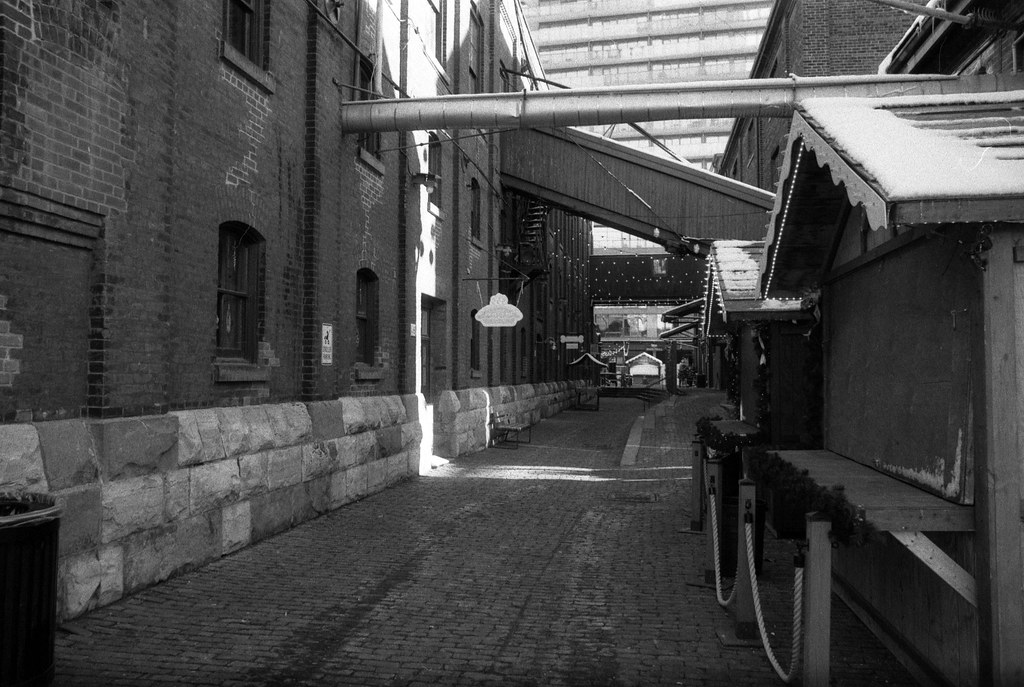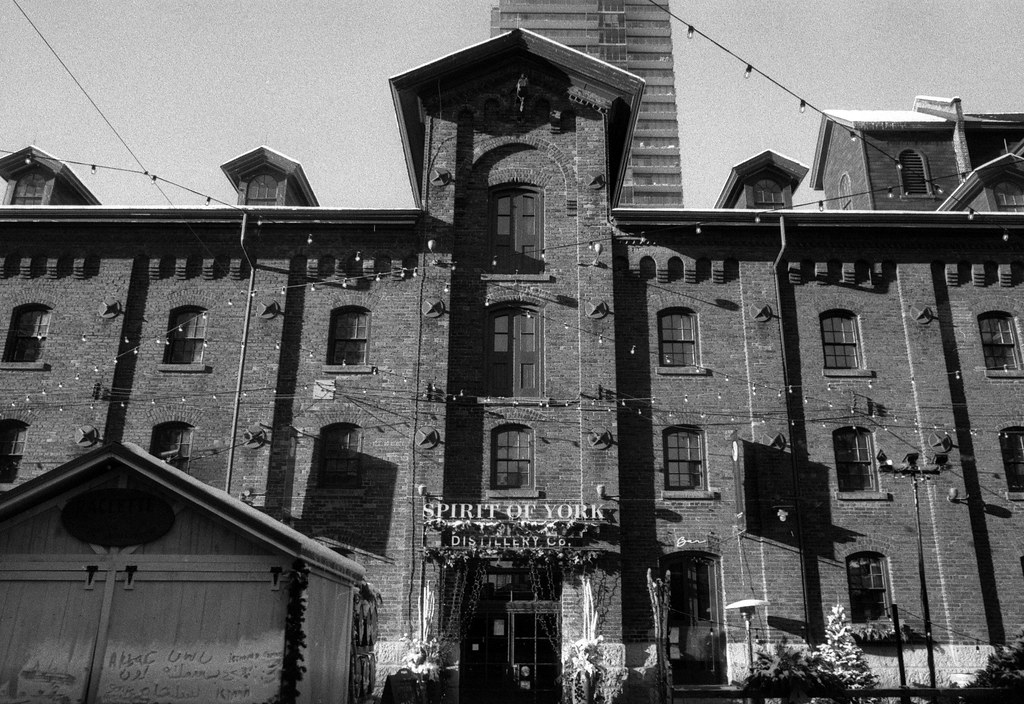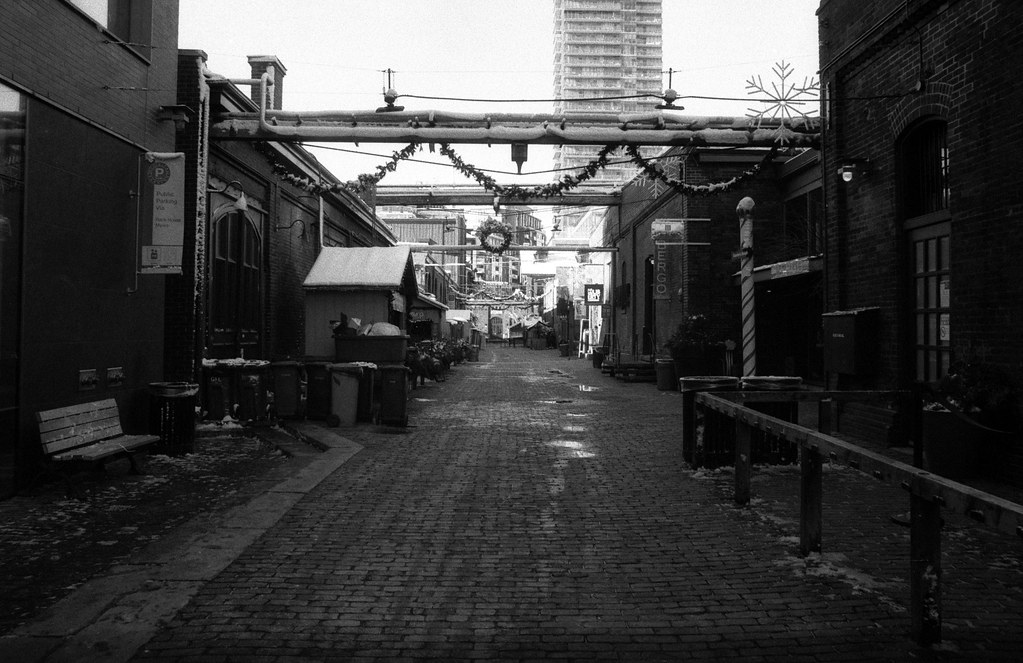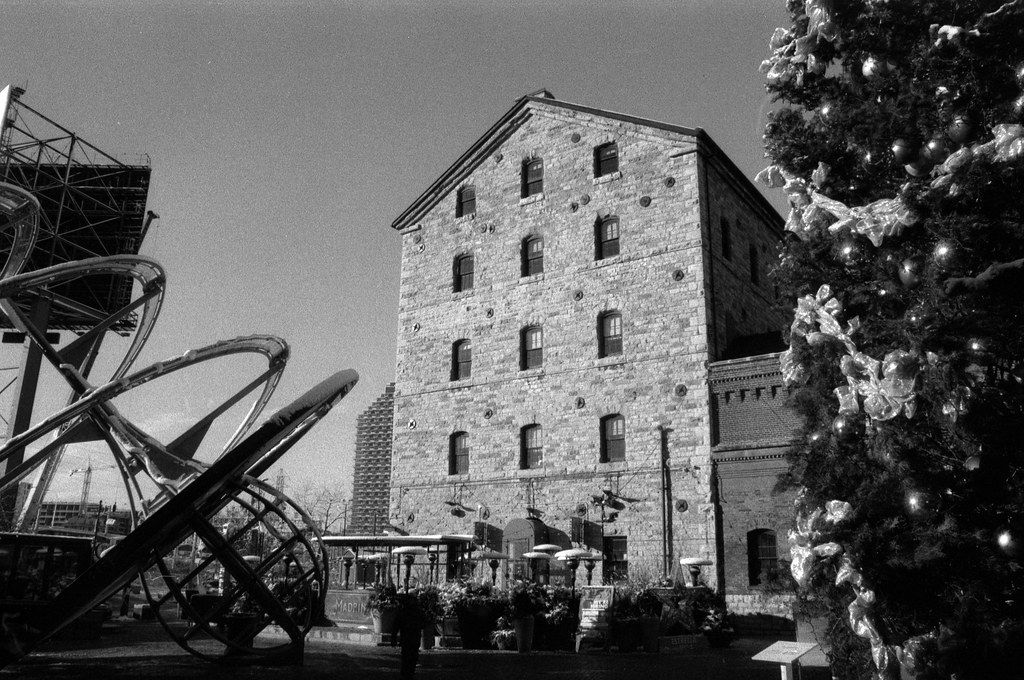There’s something special about arriving before the crowds do. When it comes to Toronto Distillery District Christmas Market, that is key to capturing both the space and the decorations. So for the final week, I ducked into Toronto in the early morning and wandered around the area before heading home and to the family times of the Christmas Season, and it seemed to be the appropriate way to end the project.

If you’ve spent any time in Toronto or are in some way involved with the arts scene, there is a good chance the Distillery District is a familiar sight. In 1831, James Wort, a miller, emigrated from Diss, England, to York in Upper Canada (Toronto, Ontario). His brother-in-law, William Gooderham, joined him there a year later. The two men established a mill at the mouth of the Don River. Their windmill became a landmark of the city’s skyline of the era; taking advantage of its access waterfront and the vast agricultural industry, the two men met with great success. Grain would come in from the surrounding farms, milled and then sent out steamships into the Great Lakes. In 1834, two week’s after his wife’s death during childbirth, James threw himself down the mill’s well, committing suicide by drowning. William would continue to operate the mill as a sole operator, but faced with a grain surplus, William began to produce spirits in 1837. In the same year, both wind and water power were replaced by steam to drive the milling and distilling processes. Gooderham’s whiskey became the mill’s primary source of income and tapped into a lucrative market. By 1845, William invited James’ eldest son, James Gooderham-Worts, to be a co-manager and, in 1856, his son, George Gooderham, into the business. The three men saw the future in distilling and hired noted Toronto architect David Roberts Jr to design a massive distillery complex. Construction of the complex began in 1859 and was completed in 1861; the old windmill came down during the construction. After one full year of production, the Gooderham & Worts Distillery produced seven million imperial gallons of spirits, approximately 3.2 million litres. It represented 25% of all the spirits produced in the Province of Canada. To help bring in more raw materials and ship out the finished product, the company invested in three railroads in the 1860s and 1870s, Toronto, Grey & Bruce, Credit Valley Railway, and Toronto & Nippissing. Using that influence, the distillery was well served by rail and ship, despite the slow movement of the Toronto shoreline. When George Gooderham took over from his father, production increased to almost 2 million imperial gallons of spirits per year or 50% of all spirits produced in Canada. By 1890 the complex had again increased in size to allow various spirits, including Rum and Industrial alcohols, to be made. During World War One, the distillery operating under the parent company British Acetones began producing chemical components to produce smokeless powder to support the war effort. After the war’s end, the rise of temperance movements and the growing popularity of beer forced the distillery’s sale to Harry C. Hatch, who in turn sold the company to Hiram Walker Distillery in 1927. Under Walker’s management, two additional buildings were added as Prohibition began to lift across Ontario, but they banked on the American market as Prohibition continued south of the border until 1933. After 1930 the distillery lost all access to the lake and could only rely on the railroad (now all former railways they invested in were part of Canadian National) and the growing automotive transport. The distillery again ramped up industrial production during World War Two, focusing on antifreeze. Whiskey production ceased in 1957, with rum and industrial alcohols continuing production until 1990. During the 1970s and the increased urban renewal and deindustrialization sweeping across Toronto, the Ontario Heritage Foundation designated the distillery to prevent any demolition; it received Federal Heritage designation in 1988. The distillery again changed hands in 1987 to the British firm, Allied Lyons. After closure, the site fell into disrepair, becoming a popular spot for the growing Urban Exploration Community and the film and television production industry. Some 800 productions were filmed at the Distillery District. Seeing the potential for a tourist spot, Cityscape purchased the shuttered distillery in 2001. Restoration began in 2002 and took a year, with a grand reopening in 2003. Today, the Distillery District is a pedestrian-friendly space and art enclave. Space is dedicated to local artists who run studios, galleries and independent shops; there is also two theatres and several coffee spots. And the brewing industry is also not lost, with Mill Street Brewery, Spirit of York Distillery and IZUMI Brewery (Ontario Spring Water Sake Company). They have also hosted a Christmas Market since 2010 and remain a popular tourist attraction in the city.


The trouble with spaces that I like is that it’s hard to pick your favourites, and I did walk away with several excellent images. However, the feature image came clear to my mind from the start. I had to try several different angles to balance the rising sun and composition. Still, I’m happy with showing off the Christmas Tree, the countdown clock and the iconic Gooderham & Worts signage that survives from the original purpose of the location. In the end, I went with my gut when choosing the rest of the images and focusing on the architecture of the space. That meant that I went with wide shots that the Distillery District indeed allows. And even in the narrow sections, there’s plenty to see.


Right from the start, I knew I wanted a wide-angle lens to capture the architecture at the distillery, but with the sun starting to shine and still getting some nice low angle light, I didn’t want anything too wide. That left the 24mm sitting at home, and while being slightly slower, the 28mm f/3.5 seemed the perfect fit. Although I would have liked to have a lens hood to help with any off-axis light as the sun crept up over the expressway. The lovely morning light helped and let me shoot the roll one last time at ASA-200. I also wanted to see how Flic Film Black/White & Green handled pulling the film in development. And it did an okay job, still plenty of contrast, sharpness and a bit of grain in the negative spaces. I had planned to bring a yellow filter along, but I’m glad I didn’t, as, in several areas, I was shooting wide open to get decent shutter speeds.


Well, folks, we’re here at the end of the project, so the next time you’ll see the project will be in the new year as I run down my favourite fifty-two images of the year.